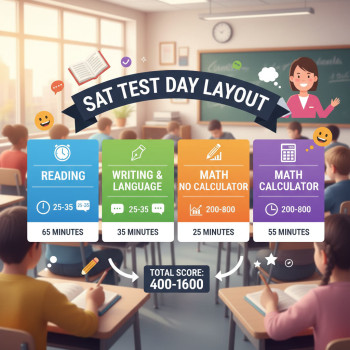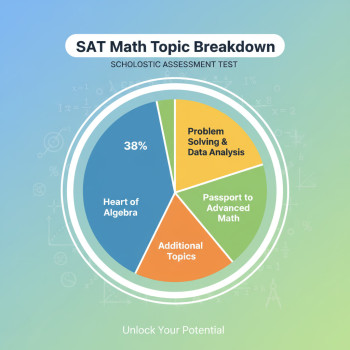Why Active Reading Matters More Than Ever for the Digital SAT
If you’re preparing for the Digital SAT, you already know that the test asks more than “do you remember what you read?” It asks: can you think with the passage—pull evidence, compare viewpoints, and apply logic under time pressure. That’s the territory where active reading wins. Passive reading—where you glide through the text hoping meaning will stick—can leave you stranded on test day. Active reading, by contrast, turns reading into a series of micro-decisions and mini-checks that make comprehension faster, recall stronger, and answer selection smarter.
What do we mean by “active” vs. “passive” reading?
At its heart, passive reading is receptive: you take in words. Active reading is interactive: you question, summarize, predict, and annotate. Imagine two students: one reads a passage and thinks, “That was interesting.” The other reads the same passage and thinks, “What’s the author’s main claim? How does paragraph 3 support it? Which line suggests skepticism?” Which student would you trust to pick the right evidence-based answer? The second one—every time.
The anatomy of an active reader: habits that translate to higher SAT scores
Active reading isn’t one trick; it’s a collection of habits you practice until they become automatic. These habits help you process passages more efficiently on the Digital SAT, where the interface and question sequencing reward clarity of thought.
1. Purpose-first reading
Before you read, set a purpose. Is this a passage about an author’s argument? A scientific study? A historical account? On the SAT, scanning the question stem first (especially evidence or command-of-evidence items) can orient you. Purpose-first reading jettisons aimless skimming and replaces it with focused intake—you’re not just reading; you’re reading to answer.
2. Micro-summarizing
After each paragraph (or every 2–3 paragraphs in denser material), mentally summarize in 6–12 words. Example: “Para 2: study shows correlation but not causation.” This micro-summary is like leaving breadcrumbs: when a question asks “According to the passage…” you already have a mental index to find the line quickly.
3. Question-generation
Turn headings, first sentences, and topic shifts into questions: “Why does the author mention X?” or “What problem does this data solve?” You don’t need to answer every question fully—just having it in your head primes your brain to look for answers and recognize them when they appear in answer choices.
4. Annotation with intent
Annotating on paper or in the Bluebook digital workspace is powerful when focused. Instead of underlining everything, mark only:
- Thesis or main claim
- Contrasts and shifts (however, yet, although)
- Names/dates when they anchor an argument
- Lines that seem to answer likely SAT question types (main idea, function, inference, evidence)
These targeted marks reduce clutter and create a faster path from stem to support.
How active reading maps to specific SAT question types
The Reading and Writing section asks a handful of predictable question types: main idea, detail, inference, function, author’s tone/attitude, and evidence/pair questions. Active reading gives you tools to approach each type strategically.
Main idea & purpose
Active reading helps you capture the author’s central claim early. When you intentionally look for the thesis and supporting structure, you can eliminate answer choices that are true but not central—one of the most common traps.
Detail questions
Micro-summaries make detail questions trivial. If you noted that paragraph 4 discussed a particular study outcome, you’ll find the exact line fast and avoid being lured by distractors that sound plausible but come from other parts of the passage.
Inference & author tone
Inference questions often require you to read between the lines—exactly the skill active readers practice when they ask “what is implied here?” Tone questions reward readers who tracked the author’s language choices: sarcasm, skepticism, guarded optimism. Active readers notice qualifiers and connotative words, which are the heartbeat of tone answers.
Evidence/pair questions
These questions force you to connect an answer choice to a supporting line. Active readers who create a mental map of where evidence lives (or annotate the support line) can match pairs quickly and accurately.
Practical active-reading strategies you can practice today
Here are concrete, repeatable techniques that transfer directly to practice tests and the Bluebook app environment.
1. The 3-minute passage scan
Before reading for details, spend up to three minutes to scan the passage: note the topic, author stance, and logical flow. Mark thesis and two structural pivots (where argument shifts or new evidence appears). This bit of upfront work often saves time when answering later.
2. The 10-Word Paragraph Summary
After each paragraph, write (or mentally state) a 10-word max summary. This discipline forces you to condense and capture essentials. If you practice this for 10 passages a week, your mental compression speed increases dramatically.
3. Active elimination
When you see choices that are partly true, ask: “Does this choice answer the question directly, or is it a true-but-irrelevant statement?” Cross out anything that doesn’t match the passage’s language or logic. Active readers eliminate more wrong answers faster.
4. Evidence match-first approach
On evidence pair items, find the evidence line first, then choose the answer that it supports. This reverses the reactive approach of choosing an answer and trying to justify it—one of the most common causes of errors.
5. Time-managed re-reads
Not all passages deserve equal time. If a question requests an inference from paragraph 1, re-read only paragraph 1 and the lines that your micro-summaries flagged. Active readers do surgical re-reads rather than re-reading entire passages under time pressure.
Sample practice plan: a 6-week active-reading bootcamp
Below is a practical schedule you can adapt. It balances skill building, strategy practice, and timed simulations. Think of it as a scaffold that grows stronger each week.
| Week | Focus | Daily Tasks (30–90 min) | End-of-week Check |
|---|---|---|---|
| 1 | Foundations: purpose, micro-summaries |
|
Accuracy on detail questions improves by 10–15% or note specific weaknesses |
| 2 | Question mapping (match question types to strategies) |
|
Identify three recurring distractor patterns you fall for |
| 3 | Evidence and inference |
|
Measure time-to-evidence (goal: <60 seconds per evidence question) |
| 4 | Timed passage simulations |
|
Track pacing and stamina; aim to finish with 5–8 minutes to spare |
| 5 | Advanced tactics & adaptive practice |
|
Notice improvements in inference and function question scores |
| 6 | Polish, error log, and practice test |
|
Final baseline: expected score increase from start |
How active reading saves time on the Digital SAT
It might sound counterintuitive: active reading involves extra steps (summarizing, annotating), so shouldn’t it take more time? In practice, targeted active reading reduces time spent hunting for answers or second-guessing yourself. A quick, precise annotation often shaves minutes off the time you’d waste re-reading whole passages. You also avoid the trap of choosing answers that feel right but are unsupported—those wrong selections cost you precious review time.
Example: the evidence-pair rescue
Imagine a question asks which line best supports the author’s claim that “technology increased disparities.” A passive reader might scan answer choices and pick a line that mentions technology and disparities in the same sentence. An active reader, however, will have flagged where the author introduced the claim and will jump straight to that paragraph, matching wording and logic. That focused path is faster and more accurate.
Common active-reading mistakes and how to fix them
Even active readers can slip. Here are common pitfalls and quick fixes.
Mistake: Over-annotating
Some students mark every sentence, creating visual noise. Fix: Mark only anchors—thesis, counters, pivots, and likely evidence lines. Less is more.
Mistake: Turning annotations into distractions
If your notes contain mini-essays, you’re wasting time. Fix: Keep annotations to 1–4 words and a quick symbol system (e.g., “T” for thesis, “C” for counter, “E” for evidence).
Mistake: Ignoring question type cues
Sometimes students treat every question the same way. Fix: Identify question type quickly—detail, inference, function, evidence—and apply the associated reading shortcut (micro-summary for details, re-read pivot paragraph for inference, etc.).
Real-world reading habits that build active-reading muscles
Active reading isn’t a test-only skill; it’s a general habit you can cultivate through everyday reading.
- Read one challenging article a day and write a one-sentence thesis and one question it raises.
- Discuss passages aloud with a friend—explaining ideas verbally forces active synthesis.
- Practice annotation in textbooks and news articles—targeted notes are a portable skill.
How personalized tutoring amplifies active-reading gains (including Sparkl’s approach)
Self-study can build active-reading muscles, but targeted guidance accelerates progress. Personalized tutoring helps in three ways:
- Diagnostic focus: A tutor identifies your specific blind spots—maybe you can identify main ideas but struggle with inference—and prescribes focused practice.
- Modeling and feedback: Tutors can demonstrate live annotation and decision-making while you practice, then correct mistakes in real time.
- Adaptive pacing: A tutor helps calibrate how much time to spend on craft techniques versus timed practice.
For example, Sparkl’s personalized tutoring offers 1-on-1 guidance and tailored study plans that adapt to your strengths and weak spots. Their expert tutors model active-reading techniques, provide targeted drills, and use AI-driven insights to help you track patterns in your mistakes—so you’re not repeating the same errors week after week. When active reading is coached the right way, gains compound quickly.
Quick wins you can apply in the next 24 hours
Try these four exercises tonight and you’ll notice more control over passages immediately:
- Do a 3-minute passage scan on one practice passage and write a one-sentence main idea.
- Summarize each paragraph in 10 words or less as you read another passage.
- Take 5 evidence-pair questions and force yourself to find the evidence line first.
- Record one timed session and review only the questions you missed—make an error-note and note the repeated pattern.
Measuring progress: metrics that matter
Don’t measure progress only by raw score. Use finer-grain metrics that show how your active-reading skills are improving:
- Time to locate evidence (average seconds)
- Percentage of correct inference questions
- Number of annotations that directly led to correct answers (self-report)
- Reduction in careless errors when re-reading under time constraints
Sample tracking table (weekly)
| Week | Avg time to evidence (sec) | Inference % correct | Number of practice passages |
|---|---|---|---|
| 1 | 95 | 48% | 10 |
| 3 | 72 | 62% | 15 |
| 6 | 51 | 78% | 20 |
How to preserve active-reading gains on test day
Habits can erode under pressure. Here are ways to ensure your active-reading strategies survive the test environment.
Simulate test conditions
Practice in the Bluebook environment or use strictly timed sections. The more your brain practices active reading under the same constraints as test day, the more automatic it becomes.
Use a short checklist
Before you start each passage, run a mental checklist: “Purpose? Thesis? Two pivots? Evidence markers?” Short, ritualized prompts reduce anxiety and keep you on strategy.
Manage energy and pacing
Active reading requires focused energy. On test day, use scheduled mini-breaks (if allowed) and energy boosts (water, snack before the test) to preserve concentration. If you feel your focus slip in a section, slow down for a 30-second scan and reset with micro-summaries.
Putting it all together: a realistic exam-day plan
Here’s a compact plan that integrates active-reading steps into a test-day routine so you can perform consistently.
- Before the exam: warm up with two 15-minute timed passages using your active-reading checklist.
- At the start of each passage: spend up to three minutes for the passage scan and mark thesis/pivots.
- For each question: identify type, use the targeted tactic (evidence-first for evidence questions), and mark answers you’d like to revisit.
- If stuck: re-read only flagged paragraph(s) and consult your micro-summaries—avoid full re-reads unless necessary.
- In the last 10 minutes: review flagged items, but avoid changing answers unless you find a clear error in reasoning.
Final thoughts: why active reading is the real test advantage
Active reading is not a flashy shortcut; it’s a disciplined way to read that aligns perfectly with what the Digital SAT tests. The shift from passive to active reading rewires how you interact with text: you stop being a consumer of words and become a critical operator of ideas. That change produces twofold value on exam day—improved accuracy and faster, more confident decision-making.
And remember: you don’t have to do it alone. If you want guided practice, targeted feedback, and a plan that adapts to your progress, consider getting help from a tutor. Sparkl’s personalized tutoring provides 1-on-1 guidance, tailored study plans, and AI-driven insights that help you track improvement patterns. With coaching, active-reading techniques move from theory to habit much faster.
Start small, be consistent, and treat every practice passage as a lab for the exact skills the SAT tests—purpose, precision, and evidence-based reasoning. That’s how active reading becomes not just a strategy, but your competitive edge.
Quick checklist to start tomorrow
- Do the 3-minute scan on one Digital SAT passage.
- Write a 10-word summary for each paragraph of another passage.
- Practice 5 evidence-pair questions using the evidence-first method.
- Log errors and look for patterns—then target one pattern next session.
Closing encouragement
Switching from passive to active reading feels awkward at first—like learning to drive stick. Give yourself focused practice, track small wins, and rely on smart help when you need it. In weeks, not months, you’ll read with intention and confidence—and that steady, intentional reading is exactly the advantage that translates into better SAT scores and stronger college-readiness skills. You’ve got this.



















No Comments
Leave a comment Cancel